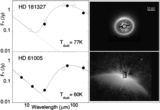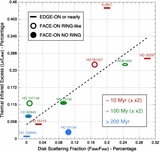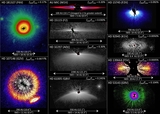Image Details

Caption: Figure 21.
(A) HD 61005 debris ring, postulated as interacting with an ISM wind. The highly inclined and centrally cleared debris ring is clearly imaged to a discernable stellocentric IWD of ~0![]() 4 with STIS 6R/PSFTSC. Linear display in SB from −1 to +8 counts s−1 pixel−1 (approximately −0.177 to 1.462 μJy arcsec−2). (B) Lower SB material (extending to much further stellocentric distances as shown in Figure 23(D)) is seen "streaming" off of the ring in a morphologically similar manner to the "streamers" reported previously for the HD 4976A high-inclination debris ring (Thalmann et al. 2011). Same display range as panel (A), but with a square-root stretch. FOV: 5
4 with STIS 6R/PSFTSC. Linear display in SB from −1 to +8 counts s−1 pixel−1 (approximately −0.177 to 1.462 μJy arcsec−2). (B) Lower SB material (extending to much further stellocentric distances as shown in Figure 23(D)) is seen "streaming" off of the ring in a morphologically similar manner to the "streamers" reported previously for the HD 4976A high-inclination debris ring (Thalmann et al. 2011). Same display range as panel (A), but with a square-root stretch. FOV: 5![]() 07 × 10
07 × 10![]() 14, north up, east left. Gray circle radius, r = 0
14, north up, east left. Gray circle radius, r = 0![]() 3.
3.
Copyright and Terms & Conditions
© 2014. The American Astronomical Society. All rights reserved.












